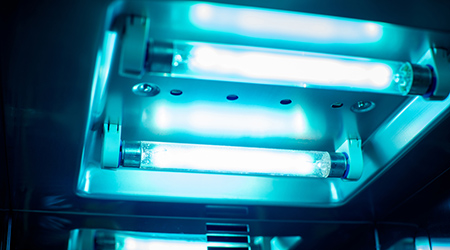When used appropriately, ultraviolet radiation is very effective at killing or deactivating pathogens. It can also cause harm to humans, so care must be taken when evaluating new technologies racing to market in a bid to help mitigate the new coronavirus, according to an article on the FacilitiesNet website.
Facility managers are familiar with UV-C technology, used commonly to keep coils clean of biofilm or used in whole-room sanitation in healthcare. The key component to both of these common applications is that they are in unoccupied space. The UV-C wavelengths emitted by these more common fixtures will cause damage to human eyes and skin.
That said, as it is effective at its intended purpose, researchers at the University of California Santa Barbara are working on developing a UV-C LED. Current UV-C lamp technology is typically mercury vapor. Researchers began their study aiming for water disinfection applications, where LED's efficiency, form factor, and durability would be extra beneficial.
One safer option for using UV-C technology in occupied space is upper-room germicidal ultraviolet (GUV). In this application, UV-C fixtures are used to continuously irradiate the air above 7 feet from the floor. Through either mechanical or natural air mixing in the room, this application boosts the amount of air that is being sanitized in the occupied room. An Illuminating Engineering Society report on GUV says that in two studies, upper-room GUV was show to be "80 percent effective against tuberculosis (TB) spread." Care must be taken to turn off the fixtures before any work is done near the ceiling, or harm can occur.
More controversial is the use of ultraviolet radiation in occupied space in a downward fixture orientation. In some ways, the continuous disinfection of surfaces and air would be a desirable outcome, but there is a lot of unknown risk with these solutions.
Read the full FacilitiesNet article.

 Code Compliance Isn't Enough for Healthcare Resilience
Code Compliance Isn't Enough for Healthcare Resilience Ribbon Cutting Marks First Phase Completion for New Montefiore Einstein Facility
Ribbon Cutting Marks First Phase Completion for New Montefiore Einstein Facility Brooks Rehabilitation Launches 3 New Major Construction Projects
Brooks Rehabilitation Launches 3 New Major Construction Projects Joint Commission Standards: What Updates Matter Most?
Joint Commission Standards: What Updates Matter Most? Swinerton Completes Construction at Atlanta's Grady Hospital
Swinerton Completes Construction at Atlanta's Grady Hospital